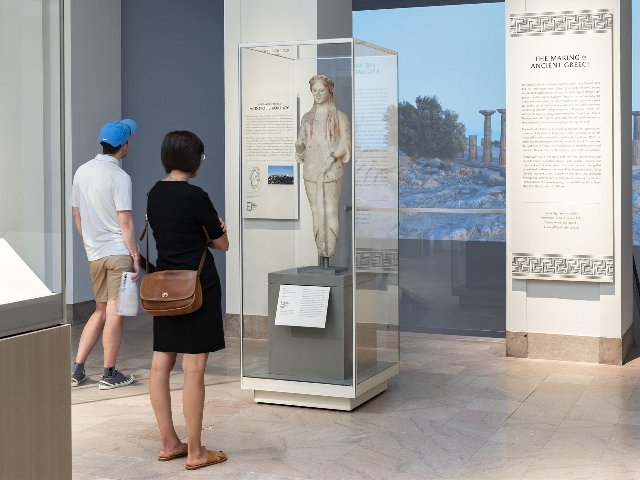Rare Loan from Acropolis of Athens
Kore on View at Museum of Fine Arts
By: MFA - Jun 05, 2023
About 2,500 years ago, the Acropolis of Athens was filled with statues of young women, called korai. Raised on high bases, these dedicated offerings created a forest of shimmering marble women honoring the goddess Athena. One of the finest examples of these objects, known as Kore 670, which rarely leaves the Acropolis Museum, has traveled to the Museum of Fine Arts, Boston (MFA), where it is on view through January 8, 2024 in the Museum’s Art of Ancient Greece, Rome and the Byzantine Empire galleries.
“I couldn’t be more excited to welcome Kore 670 to Boston and to participate in this historic exchange with Greece. She is without question one of the most dazzling and enchanting archaic sculptures, and it will be a true pleasure to witness her in dialogue with the masterpieces of the MFA’s Early Greek holdings, such as the Mantiklos Apollo. We plan to activate her presence in the gallery though public programming and learning opportunities, and we invite teachers and students of all ages to learn about Greek art and society by engaging with her,” said Phoebe Segal, Mary Bryce Comstock Curator of Greek and Roman Art.
The loan was arranged in partnership with the Hellenic Ministry of Culture and Sports and the Acropolis Museum of Athens. In exchange, the MFA has loaned three vases to the Acropolis Museum, which are on view now as part of a thematic display on employment in ancient Athens.
The MFA has produced an audio stop, narrated by Segal, on the free MFA Mobile app to offer visitors a deeper dive into the history and details of the statue.
Dedicated on the Acropolis around 510 B.C.E., Kore 670 is one of the finest examples of Greek sculpture. Originally, the statue likely stood alongside other dedications including other marble sculptures, bronze statuettes, terracotta figurines and vases. But 30 years after the statue’s creation, the Persian army invaded Athens, leaving the Acropolis in ruins. After defeating the Persians, Athenians undertook an extensive reconstruction project on the Acropolis. Many korai were buried, leaving Kore 670 underground and protected from the elements for thousands of years until 1886, when the Greeks unearthed her during systematic excavations.
Standing nearly four feet tall, the statue is crafted with elegant, detailed carving. Kore 670 wears a tunic or chiton pulled over a belt at the waist, with loose fabric overhanging. Below her waist, her left hand gathers the garment tightly around her legs. The wavy vertical folds on her torso indicate the looseness of the garment overhanging the belt, while the shallow lines radiating from the gathered fabric on her legs emphasize the tautness of the fabric held tight in her hand. Her red hair—originally a base for brown paint—cascades over her back and chest in carefully carved tresses.
The raised gesture of her right hand suggests she once carried an object, maybe a pomegranate or dove likely made of metal. She wears a curved crown with a series of drilled holes for gilt floral patterns, a carved snake bracelet on her left forearm and disc-shaped earrings.
Kore statues were originally dedicated with inscriptions on their bases identifying the men who commissioned the statue and the recipient of the offering, Athena. This statue has not been linked to a known base. Nevertheless, Kore 670 brought prestige to the dedicator as a special, elaborate gift to Athena.
Kore 670 is on view in the Museum’s Early Greek Art Gallery, which is devoted to early Greek art from its beginnings at the end of the 10th century B.C.E. through the Persian Wars (479 B.C.E.). The space is one of five galleries for the Art of Ancient Greece, Rome and the Byzantine Empire that were newly renovated in 2021.

